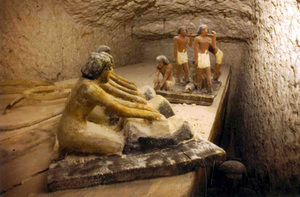Scientists from Belgium's Leuven Catholic University discovered the intact tomb in the Deir Al-Barsha necropolis in Minya, about 150 miles (241 kilometers) south of Cairo, while excavating another burial site, Egypt's culture ministry reported Sunday.
The tomb is of Henu, a courtier and real estate manager during the tumultuous First Intermediate period (2181 to 2050 B.C.) of Egyptian history.

|
| ©unk |
A cache of intact, painted statuettes of people at work, such as women making beer and pounding cereal, were arranged in the tomb.
Other statuettes featured a man working clay with a hoe and two other men carrying a bag of clay suspended from a pole.
The team also discovered a statuette of Henu in his official costume.
The mummy of Henu himself was wrapped in linen and placed in a large, wooden coffin, which was decorated with hieroglyphics. The coffin contained two wooden sandals lashed with rope.
Many of the objects feature "realistic touches and unusual details," Harco Williams, head of the Belgian team, said in a statement.
For instance, the ancient artists painted dirt on the hands and feet of their statuettes.
"The statuettes are considered the best quality of their time," Williams said.



Reader Comments
to our Newsletter